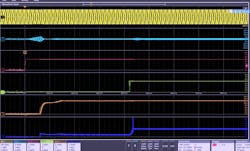If Rip Van Winkle were a modern-day design engineer who just woke up from his 20-year nap he would be bewildered by what has happened to oscilloscopes, the engineer’s basic design and debugging tool. Oscilloscopes are no longer on a cart with wheels, the display is now larger than a cathode ray tube face, and it is multi-colored. And, the scope fits on a benchtop with plenty of room to spare.
The obvious difference Mr. Van Winkle would find in an oscilloscope today is that they are digitized. They store a digital copy of the input waveform in digital memory, which they then analyze using digital signal processing techniques and display the waveform. They are now the most common type of oscilloscope because they offer the advantages of storage, display, fast traces rate, and wide bandwidth.
All oscilloscopes are not created equal, however, particularly the new Tektronix 5 Series MSO (Mixed Signal Oscilloscope), seen below. The three versions of this scope provide 4, 6, or 8 FlexChannel inputs. As systems become more complex and debug problems become more difficult, engineers have found they need more than four input channels. In some applications more than four analog and digital channels are needed for power electronic system designs. Multiple channels provide the ability to correlate multiple analog and digital inputs, which is critical to gaining an accurate, synchronous view in a complex mixed signal system.
The Tektronix MSO56, 500MHz, 8-channel input digital storage oscilloscope with 15.6-inch (diagonal) HD capacitive touch display.
This MSO’s FlexChannels are reconfigurable to accommodate either analog or digital inputs. By default, the input is a TekVPI connector that accepts TekVPI analog probes. Connecting an input to the new TLP058 Logic Probe converts it to eight digital channels. The designer can add as many logic probes as needed, enabling 8 to 64 digital channels. Digital signals are sampled, triggered, and stored the same as analog signals, which simplifies signal comparisons.
Another scope innovation is the 5 Series MSO’s 15.6-in. capacitive-touch, high-definition (1920 x 1080 pixel) display. With the display comes an advanced user interface that lets designers access controls directly through objects on the display rather than having to navigate through menus or use knobs to change operating modes. The result is a faster and more intuitive operation along with considerably more space for viewing waveforms and correlating signals. If desired, designers can also control the oscilloscope using a mouse or conventional front-panel controls.
The 15.6-inch-high definition (1920 x 1080 pixel) multicolor display presents eight channels of analog and digital data from a mixed signal system.
Touchscreen capability allows the designer to:
- Access configuration menus by simply double tapping relevant items on the display
- Directly access desired controls through objects on the display rather than navigating from one menu to another
- Move a transparent configuration menu on the screen if it blocks something of interest
Jitter measurements are simplified by:
- DPOJET functionality integrated into the scope application, provides faster and more intuitive operation
- Accessing them in the same simple manner as all other base measurements
- Display of a Jitter Summary, including:
- Bathtub plots
- TIE Histograms
- TIE Spectrums
- Eye Diagrams
Oscilloscopes must have inherently low noise to allow observation of signal amplitudes coping with low signal-to-noise ratio backgrounds. To meet this requirement, the 5 Series MSO incorporates:
- Advanced front end amplifier that lowers noise approximately 4.5 dB from previous generation oscilloscopes.
- 12-bit analog-to-digital converter delivers 16 times the resolution of older generation 8-bit ADCs
- High resolution mode that delivers up to 16 bits of vertical resolution for even finer view of low frequency signals
- Unique DSP filter applied at each sample rate limits bandwidth and thus, noise, providing a more accurate view of the signal
- Combination of low noise and high resolution ADC delivers Effective Number of Bits (ENOB) listed in Table 1.
The 5 Series MSO can run as either a dedicated scope or an open Windows configuration. You can switch between the two simply by adding or removing a solid-state drive (SSD) that has a Windows license/OS installed on it. With the SSD installed, the instrument boots Windows. (Windows OS option may be pre-ordered immediately for delivery in September 2017).With the SSD removed, the instrument boots as a dedicated scope. Regardless of the configuration, the scope’s user interface drives exactly the same way. The instrument has an access panel for installation/removal of a solid-state drive for use with the Windows configuration. You can configure the instrument according to your own preference, for example:
- A dedicated scope w/o Windows (simple, secure, etc.)
- Running other applications on the scope, using extended monitors, etc.
- In either configuration, the user interface/experience is identical
- You can remove the SSD at any time to extend the scope’s life as a dedicated instrument
Along with the display and user interface, the 5 Series MSO features an attractive and modern industrial design. The compact instrument is less than 8-inches deep with a rugged handle, a streamlined and intuitive front panel with LED light rings indicating selected waveform and trigger sources, and adjustable feet that enable additional viewing angles.
You can purchase all 5 Series MSOs field upgrades (with 4, 6, or 8 FlexChannels) as needs change. This includes an arbitrary/function generator (AFG), digital probes, extended record length up to 125 Mpoints, and additional protocol support. The scopes are all backed by a three-year warranty.
Features can be upgraded at any time after initial purchase, including:
- Bandwidth
- Up to 1 GHz can be upgraded in the field via a license
- Up to 2 GHz must be performed by an authorized Tektronix service center
- Additional Digital Channels
- Obtain more TLP058 logic probes
- Field Upgrades via License
- Record length to 125M/channel
- Arbitrary/Function Generator
- DVM & trigger frequency counter provided free with product registration
- Jitter analysis support
- Serial trigger/decode analysis packages
- Solid state drive with Windows license
Table 2 lists the characteristics of the 5 Series MSO oscilloscopes.





